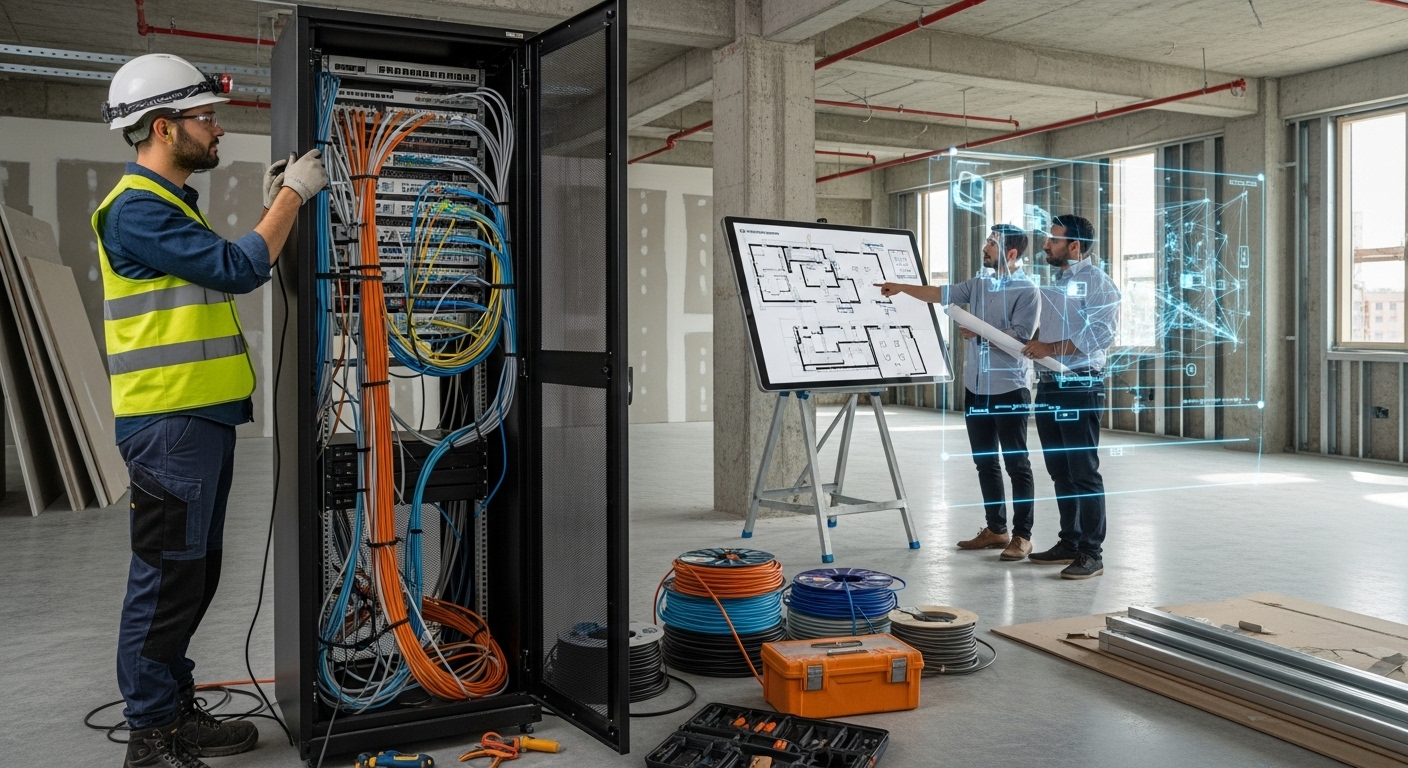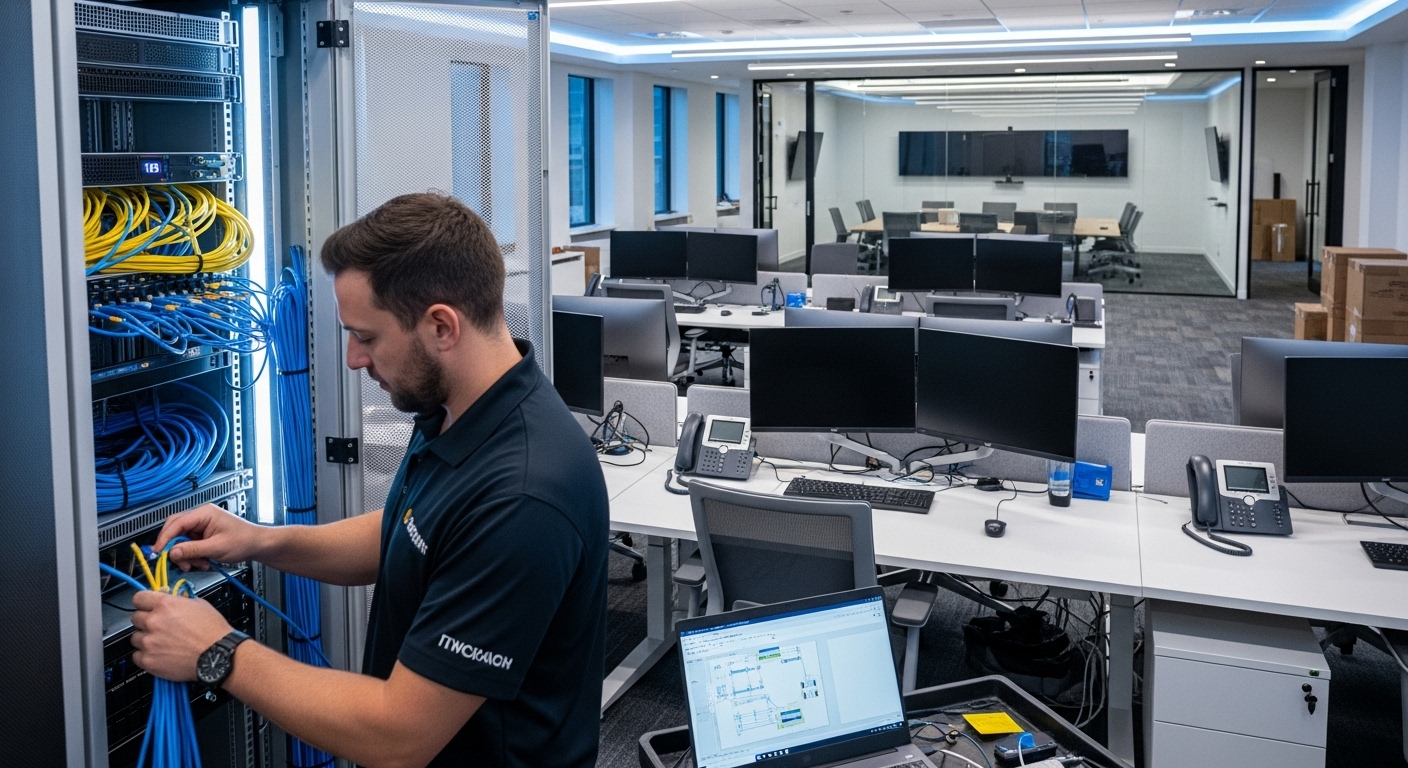In the complex choreography of designing and launching a new workspace, IT infrastructure is often treated as just another item on a long checklist, addressed somewhere between choosing the furniture and planning the move-in day. This is a critical mistake. In today’s digitally-driven business environment, your IT and network infrastructure are not just a component of the office; they are the foundational utility upon which all other operations depend. Treating IT as an afterthought is a recipe for budget overruns, operational bottlenecks, and a workspace that is obsolete before it even opens. The new paradigm for workplace design and logistics demands that IT be considered ‘Day Zero’—a core element integrated into the architectural blueprint itself. This strategic shift from reactive setup to proactive integration ensures scalability, enhances security, and builds a resilient digital backbone that can support your organization’s growth for years to come.
Aligning blueprints and bandwidth: why IT needs a seat at the design table
The decision to move or build a new office is a significant capital investment. To maximize that investment, IT infrastructure cannot be an overlay; it must be woven into the very fabric of the building’s design. Engaging IT specialists and network architects during the initial architectural planning phase is crucial. This early collaboration allows for the strategic placement of essential infrastructure, such as server rooms, network closets, and wireless access points. A well-placed server room, for instance, requires specific considerations for cooling, power, and security that are far easier and more cost-effective to implement during construction than to retrofit later. Similarly, mapping out structured cabling routes alongside electrical and HVAC plans prevents interference and ensures optimal performance. This proactive approach avoids costly change orders and construction delays. More importantly, it ensures that the physical space is designed to support the technological needs of a modern workforce, from high-density Wi-Fi in collaboration areas to the fiber optic backbones required for data-intensive operations. By treating IT as a foundational utility, businesses can create a workspace that is not only functional on day one but also agile enough to adapt to future technological advancements without requiring a complete overhaul.
The nervous system of your workspace: mastering structured cabling and network design
If the office is the body, the structured cabling is its central nervous system, carrying critical data to every corner of the organization. A piecemeal or shortsighted approach to cabling is a primary cause of future network issues. The best practice is to design a system that anticipates future growth and technological evolution. This means investing in higher-performance cabling, such as Cat6A or even fiber optics, to support increasing bandwidth demands. A key recommendation is to plan for 150-200% of your current needs, ensuring that future expansion doesn’t require tearing open walls. Equally important is the network design itself. A thorough assessment of business requirements—including the number of connected devices, data sharing protocols, and remote access needs—must inform the network’s architecture. Implementing a robust security framework from the outset is non-negotiable. This involves integrating firewalls, intrusion detection systems, and secure VPNs for remote and hybrid teams. Standardizing hardware and software across the organization is another crucial step, as it simplifies deployment, streamlines maintenance, and reduces training time for both end-users and IT staff, creating a more efficient and secure operational environment.
Securing your assets: integrating physical and digital security from the start
In an era of sophisticated cyber threats, security cannot be a bolt-on solution. An effective IT setup integrates cybersecurity into both the digital and physical design of the workspace. This holistic approach begins with the physical layout. Server rooms should be secure, climate-controlled spaces with restricted access. Network closets should be locked and strategically placed to prevent unauthorized tampering. But physical security is only half the battle. The digital security architecture must be just as robust. Implementing a zero-trust network architecture, where no user or device is trusted by default, is rapidly becoming the standard. This approach helps to contain potential breaches and protect sensitive data. Furthermore, a comprehensive data management strategy is essential for business continuity. A widely recommended best practice is the ‘3-2-1 rule’ for backups.
“The 3-2-1 backup strategy involves having at least three total copies of your data, two of which are local but on different mediums, and at least one copy off-site.”
This ensures data can be recovered in the event of hardware failure, natural disaster, or a ransomware attack. By weaving physical access controls and digital security protocols together from day zero, you create a multi-layered defense that protects your company’s most valuable asset: its data.
Future-proofing your foundation: embracing cloud, AI, and sustainable tech
A new office build is the perfect opportunity to shed legacy systems and embrace technologies that offer flexibility and a competitive edge. The modern IT landscape is increasingly dominated by hybrid and multi-cloud strategies, which allow businesses to blend the security of on-premises infrastructure with the scalability of various cloud services. This flexible approach optimizes where workloads run, balancing cost, performance, and compliance. Another significant trend is the integration of Artificial Intelligence (AI) and Machine Learning (ML) into IT operations. These technologies are no longer theoretical; they are practical tools for automating routine tasks, predicting hardware failures, and identifying security threats in real-time. This frees up IT teams to focus on strategic initiatives rather than reactive firefighting. Simultaneously, sustainability in IT, or ‘Green Tech,’ is gaining prominence. This involves designing energy-efficient data centers, prioritizing hardware with low power consumption, and establishing responsible e-waste recycling programs. A sustainable IT strategy not only reduces a company’s carbon footprint but can also lead to significant long-term cost savings on energy, making it a smart business decision that aligns with corporate social responsibility goals.
The logistics of launch: a phased approach to IT relocation and setup
Even with perfect planning, the physical act of moving and setting up IT equipment is fraught with risk. A meticulously planned, phased approach is essential for a smooth transition. The process should begin with a comprehensive audit of all existing hardware and software assets. This inventory allows you to identify outdated technology that needs to be retired and ensure all necessary software licenses are in place for the new location. For the equipment that is making the move, proper decommissioning and transportation are critical. Sensitive electronics should be packed in anti-static materials and handled by professional movers experienced in IT relocations. The setup at the new office should be executed in a logical sequence. Core networking infrastructure—routers, switches, and firewalls—should be installed and thoroughly tested before any servers or workstations are connected. Internet circuits and phone lines should be ordered months in advance and confirmed to be active well before move-in day. Finally, a crucial but often overlooked step is post-move support. Having IT staff on-site and easily accessible during the first few weeks is vital for troubleshooting the inevitable minor issues that arise, ensuring employees can be productive from the moment they walk in the door.
Beyond day one: planning for ongoing IT management and scalability
A successful IT setup is not a one-time project; it’s the beginning of an ongoing process of management, maintenance, and strategic evolution. Your new office’s IT infrastructure should be designed for scalability, allowing for seamless growth without disruptive and expensive overhauls. This involves the physical space, such as ensuring server racks have room for additional hardware, and the network architecture, which should be flexible enough to accommodate more users and devices. Proactive monitoring and maintenance are key to ensuring reliability and performance. Implementing network monitoring tools can help identify potential issues before they escalate into major problems. A comprehensive documentation strategy is also essential for efficient ongoing management. All aspects of the network—from cabling diagrams to device configurations and software licenses—should be meticulously documented. This information is invaluable for troubleshooting, training new IT staff, and planning future upgrades. By establishing these protocols from the outset, you transition from a reactive ‘break-fix’ model to a proactive, strategic approach to IT management. This ensures that the technological foundation you’ve built not only supports your business today but also serves as a powerful engine for future innovation and growth, adapting to new challenges and opportunities as they arise.
Ultimately, integrating IT into the foundational stages of office design is a strategic imperative. It shifts the perception of IT from a cost center to a critical business enabler that drives efficiency, security, and innovation. By giving IT a seat at the design table, businesses can avoid the common pitfalls of inadequate planning, such as poor connectivity and costly retrofitting. A well-designed digital infrastructure, built on scalable structured cabling, robust security protocols, and forward-thinking technology, becomes the resilient backbone of the entire operation. This proactive approach ensures that when employees walk into their new workspace, the technology is not just functional but invisible, seamless, and ready to support their best work. This isn’t just about connecting computers; it’s about building a future-ready environment that can adapt and grow in lockstep with your organization’s ambitions, ensuring your investment pays dividends for years to come.





